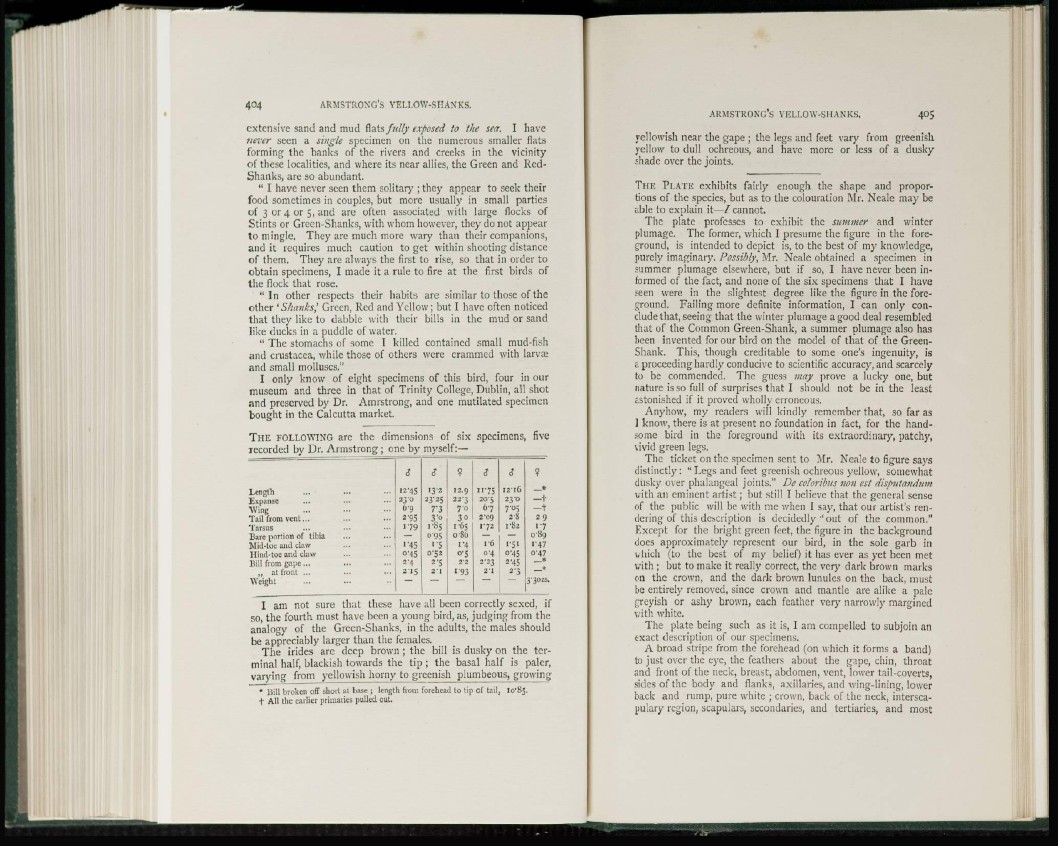
extensive sand and mud flats fully exposed to the seer. I have
never seen a single specimen on the numerous smaller flats
forming the banks of the rivers and creeks in the vicinity
of these localities, and where its near allies, the Green and Red-
Shanks, are so abundant.
" I have never seen them solitary ; they appear to seek their
food sometimes in couples, but more usually in small parties
of 3 or 4 or 5, and are often associated with large flocks of
Stints or Green-Shanks, with whom however, they do not appear
to mingle. They are much more wary than their companions,
and it requires much caution to get within shooting distance
of them. They are always the first to rise, so that in order to
obtain specimens, I made it a rule to fire at the first birds of
the flock that rose.
"In other respects their habits are similar to those of the
other ' Shanks] Green, Red and Yellow ; but I have often noticed
that they like to dabble with their bills in the mud or sand
like ducks in a puddle of water.
" The stomachs of some I killed contained small mud-fish
and C r u s t a c e a , while those of others were crammed with larvce
and small molluscs."
I only know of eight specimens of this bird, four in our
museum and three in that of Trinity College, Dublin, all shot
and preserved by Dr. Amrstrong, and one mutilated specimen
bought in the Calcutta market.
THE FOLLOWING are the dimensions of six specimens, five
recorded by Dr. Armstrong ; one by myself:—
Length
Expanse
Wing
Tail from vent...
Tarsus
Bare portion of tibia
Mid*toe and claw
Hind-toe and claw
Bill from gape ...
,, at front ...
Weight
t c" ¥ 0* c? ¥
•2'45 13a 12.9 n-75 I2-I6 —*
2J0 23-25 22'3 205 23-0 —+
6-9 Ti 7-0 67 705 —t
2-95 3'o 3D 2-09 2 5 29
179 1-85 I-65 1-72 1-82 1-7
— o'95 086 — — 089
1'45 >5 1'4 1-6 1-5' 1-47
o-45 0-52 0-5 04 0-45 047
2 4 2'5 22 2-23 2-45 * 215 21 193 21 2-3 —*
3'3OZS.
I am not sure that these have all been correctly sexed, if
so, the fourth must have been a young bird, as, judging from the
analogy of the Green-Shanks, in the adults, the males should
be appreciably larger than the females.
The irides are deep brown ; the bill is dusky on the terminal
half, blackish towards the tip ; the basal half is paler,
varying from yellowish horny to greenish plumbeous, growing
* Bill broken off short at base ; length from forehead to tip of tail, lo"S5.
f All the earlier primaries pulled out.
ARMSTRONG'S YELLOW-SHANKS. 405
yellowish near the gape ; the legs and feet vary from greenish
yellow to dull ochreous, and have more or less of a dusky
shade over the joints.
THE PLATE exhibits fairly enough the shape and proportions
of the species, but as to the colouration Mr. Neale may be
able to explain it—/cannot.
The plate professes to exhibit the summer and winter
plumage. The former, which I presume the figure in the foreground,
is intended to depict is, to the best of my knowledge,
purely imaginary. Possibly, Mr. Neale obtained a specimen in
summer plumage elsewhere, but if so, I have never been informed
of the fact, and none of the six specimens that I have
seen were in the slightest degree like the figure in the foreground.
Failing more definite information, I can only conclude
that, seeing that the winter plumage a good deal resembled
that of the Common Green-Shank, a summer plumage also has
been invented for our bird on the model of that of the Green-
Shank. This, though creditable to some one's ingenuity, is
a proceeding hardly conducive to scientific accuracy, and scarcely
to be commended. The guess may prove a lucky one, but
nature is so full of surprises that I should not be in the least
astonished if it proved wholly erroneous.
Anyhow, my readers will kindly remember that, so far as
I know, there is at present no foundation in fact, for the handsome
bird in the foreground with its extraordinary, patchy,
vivid green legs.
The ticket on the specimen sent to Mr. Neale to figure says
distinctly: "Legs and feet greenish ochreous yellow, somewhat
dusky over phalangeal joints." De coloribus no?i est disputa?idum
with an eminent artist ; but still I believe that the general sense
of the public will be with me when I say, that our artist's rendering
of this description is decidedly •'out of the common."
Except for the bright green feet, the figure in the background
does approximately represent our bird, in the sole garb in
which (to the best of my belief) it has ever as yet been met
with ; but to make it really correct, the very dark brown marks
on the crown, and the dark brown lunules on the back, must
be entirely removed, since crown and mantle are alike a pale
greyish or ashy brown, each feather very narrowly margined
with white.
The plate being such as it is, I am compelled to subjoin an
exact description of our specimens.
A broad stripe from the forehead (on which it forms a band)
to just over the eye, the feathers about the gape, chin, throat
and front of the neck, breast, abdomen, vent, lower tail-coverts,
sides of the body and flanks, axillaries, and wing-lining, lower
back and rump, pure white ; crown, back of the neck, interscapulary
region, scapulars, secondaries, and tertiarics, and most